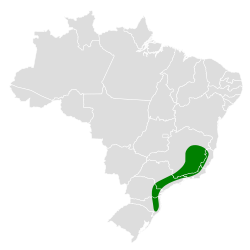| Brassy-breasted tanager | |
|---|---|
 | |
| Scientific classification | |
| Domain: | Eukaryota |
| Kingdom: | Animalia |
| Phylum: | Chordata |
| Class: | Aves |
| Order: | Passeriformes |
| Family: | Thraupidae |
| Genus: | Tangara |
| Species: | T. desmaresti |
| Binomial name | |
| Tangara desmaresti | |
 | |
| Synonyms | |
| |
The brassy-breasted tanager (Tangara desmaresti) is a species of bird in the family Thraupidae. It is endemic to Brazil. Its natural habitat is subtropical or tropical moist montane forests.
